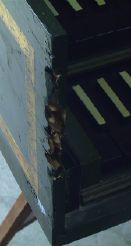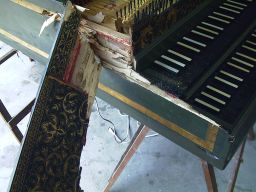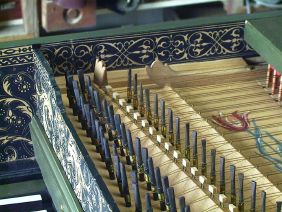Restoration Report
Copyright © 2003 CBH on the spine replacement of the
Michael Thomas French Double Harpsichord in an antique
case
privately owned in Singapore
Restoration ReportCopyright © 2003 CBH on the spine replacement of the |
 NASA VISIBLE EARTH |
Problem The instrument was fumigated, crated, airfreighted, and quarantined on arrival in Sydney prior to delivery to the workshop. |
 |
 |
Insect identification Singaporean drywood termites are particularly dangerous. At times these insects are capable of just flying in and establishing a colony in any piece of wood in your home. They require neither decayed wood, nor wood that is in contact with moisture. |
Removal of the existing spine Complete replacement of the spine was only practical in this instrument because of the substantial case structure from Dolmetsch, with slightly thicker than normal liners, a wrestplank horse arrangement with integral keyend blocks, as well as a bottom reinforcement probably dating from one of the European restorations of the 1980s. |
 |
 |
The string tension was reduced, and the eaten spine carefully removed from the structure of the case. The soundboard and its associated spine moulding remained in place throughout the repair. It was established that the infestation was largely confined to the wood of the spine and the short beech block spanning the gap under the bass end of the registers. Damaged areas of the spine liner were cleaned and filled with epoxy compound to ensure sufficient strength. |
Attachment of the new spine |
 |
 |
Decoration Stringing & Action |
Conclusion
The instrument was packed for return by airfreight to Singapore in April 2003.
After reacclimatization, the harpsichord was briefly checked during an Asian maintenance tour in late May 2003. The repair was judged a success by the owner, with increased tuning stability.
| Restoration | |
| Site overview | |
| Harpsichords Australia Home Page |